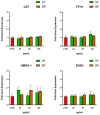Origanum majorana Extracts: A Preliminary Comparative Study on Phytochemical Profiles and Bioactive Properties of Valuable Fraction and By-Product
- PMID: 40805613
- PMCID: PMC12348732
- DOI: 10.3390/plants14152264
Origanum majorana Extracts: A Preliminary Comparative Study on Phytochemical Profiles and Bioactive Properties of Valuable Fraction and By-Product
Abstract
Origanum majorana L. (O. majorana) (Lamiaceae) is an aromatic Mediterranean plant widely used in food, cosmetics, and traditional medicine due to its aroma and rich content of bioactive compounds. While its leaves and flowers are commonly utilized, lignified stems are often discarded. This study compared hydroalcoholic extracts from the leaves and flowers (valuable fraction, VF) and stems (by-product, BP). Phytochemical analysis revealed qualitatively similar profiles, identifying 20 phenolic compounds, with Rosmarinic acid and Salvianolic acid B as the most and second most abundant, respectively. Antioxidant activity was evaluated in vitro using DPPH (IC50 [µg/mL]: VF 30.11 ± 3.46; BP 31.72 ± 1.46), H2O2 (IC50 [µg/mL]: VF 103.09 ± 4.97; BP 119.55 ± 10.58), and O2•- (IC50 [µg/mL]: VF 0.71 ± 0.062; BP 0.79 ± 0.070). Both extracts (20 µg/mL) fully restored oxidative balance in hemin-stressed AC16 cardiomyocytes, without altering the expression of catalase, heme-oxygenase 1, superoxide dismutase 2, or ferritin. Anti-inflammatory activity in LPS-stimulated RAW 264.7 macrophages showed that VF (IC50 400 µg/mL) reduced •NO release to control levels, while BP achieved a ~60% reduction. Cytotoxicity was assessed on cancer cell lines: CaCo-2 (IC50 [µg/mL]: VF 154.1 ± 6.22; BP 305.2 ± 15.94), MCF-7 (IC50 [µg/mL]: VF 624.6 ± 10.27; BP 917.9 ± 9.87), and A549 (IC50 [µg/mL]: VF 720.8 ± 13.66; BP 920.2 ± 16.79), with no cytotoxicity on normal fibroblasts HFF-1 (IC50 > 1000 µg/mL for both extracts). Finally, both extracts slightly inhibited only CYP1A2 (IC50 [µg/mL]: VF 497.45 ± 9.64; BP 719.72 ± 11.37) and CYP2D6 (IC50 [µg/mL]: VF 637.15 ± 14.78, BP 588.70 ± 11.01). These results support the potential reuse of O. majorana stems as a sustainable source of bioactive compounds for nutraceutical and health-related applications.
Keywords: Rosmarinic acid; cancer; cytochrome P450 isoforms; inflammation; oxidative stress; polyphenols; sustainability.
Conflict of interest statement
The authors declare no conflicts of interest.
Figures








References
-
- Origanum majorana L. [(accessed on 6 May 2025)]. Available online: https://powo.science.kew.org/taxon/urn:lsid:ipni.org:names:453303-1.
-
- Ietswaart J.H. A taxonomic revision of the genus Origanum (Labiatae) Leiden Bot. Ser. 1980;4:1–153.
-
- Lukas B., Novak J. Origanum majorana L. (Marjoram) In: Novak J., Blüthner W.D., editors. Medicinal, Aromatic and Stimulant Plants. Handbook of Plant Breeding. Volume 12. Springer; Cham, Switzerland: 2020. pp. 407–417. - DOI
-
- Dikr W. Role of Intercropping some Aromatic and Medicinal Plants with Fruit Vegetables Crops, a Review. Glob. Acad. J. Agri. Biosci. 2022;4:22–30. doi: 10.36348/gajab.2022.v04i02.002. - DOI
Grants and funding
LinkOut - more resources
Full Text Sources

